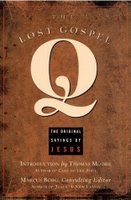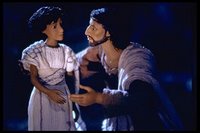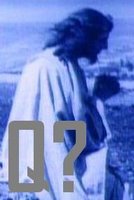
I read Marcus Borg's
"The Lost Gospel Q: The Original Sayings of Jesus" yesterday. I say Borg's but really his role was to be consulting editor and contribute a preface which, somewhat unusually, comes after Thomas Moore's introduction. However, neither man is responsible for the main section of the book - a collation and translation of the various sayings of Jesus that form the hypothetical source known as Q - This work was completed by Mark Powelson and Ray Riegert.
Whilst I'm not so much of a Q-sceptic as
Mark Goodacre, whose
two books on the subject are well worth a read, I'm certainly cynical about Q, and the amount of certainty that seems to rest on the hypothesis. So it was with mixed feelings I plucked this book off the shelf. Part of me thought it would be interesting to read all this sayings material in one volume, not to mention reading Borg's preface. On the other hand, bringing all the material into just one volume seems far too confident and final to me.
For the uninitiated, Q is one of the solutions to what has been called the synoptic problem - the fact that the gospels of Matthew, Mark and Luke contain so much similar material to one another. It is generally accepted nowadays that Mark's gospel was written first, and the reason that it shares so much common material with the other two "synoptic" gospels is because the writers of those gospels knew Mark's gospel, and based their gospels on it. (There are, some who maintain that Matthew was also the source for Mark, but I'll put that aside for now).
However, further examination of Matthew and Luke also reveals that there is also a large amount of material that they have in common. Three broad theories have been suggested to explain this phenomenon. Firstly that Luke knew Matthew's gospel, and used phrases from his gospel as well as Luke's as a basis for his gospel. Alternatively, the process could have worked the other way around with Matthew adapting Luke instead. The most popular solution to this theory, however, is that there was a third source, which, (somehow) was lost to such an extent that it wasn't even preserved by being directly referenced in other ancient texts, which both Matthew and Luke used independently, without knowing each other's work. And it is this lost source which has been named Q (after the German word for source "Quelle").
"The Lost Gospel Q", then, is basically a presentation of a reconstructed version of that source, produced for a wider readership than that which usually dips into books on the synoptic problem. No doubt
"The Da Vinci Code" has created increased audience interest for such a book. One does not have to read very far into the book before we find an astounding level of confidence in the composition of this lost source, and its purity in contrast to the canonical gospels. The very first page contains this statement by Moore:
...the four gospels are riddled with the interpretations, biases and agendas of their four editors...The Lost Gospel Q, (is) the scholars' best attempt to render the pure voice of the Gospel Jesus
Now perhaps if Moore was pushed on this he would point out the detail in that statement, but when swept across, as much of the targeted readership would do, then it certainly gives the impression that Q represents a pure voice in contrast to the bias of the canonical gospels. In reality, if Q did exist, it would have reflected the biases of the community behind it, just as much as those of the communities of Matthew, Mark and Luke.
I also find the confidence behind this composition astounding. Borg's statement on page 17 that "Q contains no passion narrative" is sheer conjecture. All we know is that if Q existed then both Matthew and Luke chose Mark's version. That may be, as Borg contends, because Q had no passion narrative, but it may be that Mark's version was simply better, or at least more suitable to Matthew and Luke's purposes than that of Q. Secondly, there is an implicit assumption that the material unique to Matthew and Luke, named M and L respectively, was also not by definition part of Q. That is all very well when naming sources to explain the model, but when attempting to reconstruct the model, it is a little too certain. How do we know that Matthew and Luke incorporated everything from Q into their gospels? That is certainly not the way they handled Mark, both authors excluded certain sections. So how do we know that some of the M and L material was not in the Q source, but that the other evangelist chose to leave it out either deliberately, because it did not suit their purpose, or accidentally? And, as noted with the passion narrative, how do we know that there are incidents that both writers excluded. Borg notes that the Gospel of Thomas also excludes the death and resurrection of Jesus, but to assume that Q follows this pattern rather than the pattern of the other 4 known gospels is also a bit of a leap. The evidence from the earliest gospels is 4:1 against, and Thomas may not even be that early. Certainly it is the least Jewish of all the gospels which suggests a certain period of time is likely to have elapsed for the gospel of a Jewish teacher to drift so significantly. It is certainly possible that Q had no passion narrative, but the burden of proof would lie on those who deny it on this basis.

A brief excursus here to return to the staple ground of this blog. Consider the various films about Jesus. Most of them pick and choose biblical episodes as best suits them. Some incidents occur in all, or nearly all films. Others are very prominent in certain films such as the healing of Jairus's daughter in
The Miracle Maker, but entirely absent in others such as the
Jesus mini-series. Other parts of the gospel, such as the parable of the shrewd manager, are never included (unless the film is a presentation of the entire gospel). Yet all are in the source material. In other places the film-makers clearly prefer one version of an event to another for example where
Il Messia locates the clearing of the Temple at the start of the story, as in John, rather than at in Jesus's final week like the synoptics.
Overall, Borg is a little more cautious than Moore, but the presentation of the actual "gospel" leaves no room for doubt, as it consists solely of the material common to Matthew and Luke, but not found in Mark. The juxtaposition of confident assertion over the nature of Q, and a definitively framed collection of sayings suggests a certainty over Q that is just not fitting a hypothetical source. As a result the books falls halfway between two more sensible positions - either a simple collection of the material that is not in Mark but that is common to Matthew and Luke, or some conjecture based around that common material. If the writers wanted to make all sorts of definitive claims about this gospel it would have been better to include an appendix with a few disputed sayings for the record, and accompanying comments (as we have with all of the canonical gospels).
The book itself is nicely laid out with a number interesting comments, and is a good introduction to the authors' positions. The use of red text for the words of Jesus is also useful here, as are the notes on translation, and the chart equating the Q sayings to Matthew and Luke. However, as an introduction to Q itself it is so overconfident that it loses a little of its credibility.
Labels: Historical Jesus, Jesus Seminar
 Having taught on Matthew, Mark and Luke in the autumn, I've been mulling over various issues related to the synoptic problem. One thing that I've been thinking about in particular is the ideological convenience of Q (the hypothesised sayings gospel which the majority of scholars believe was the source for the material shared only by Matthew and Luke).
Having taught on Matthew, Mark and Luke in the autumn, I've been mulling over various issues related to the synoptic problem. One thing that I've been thinking about in particular is the ideological convenience of Q (the hypothesised sayings gospel which the majority of scholars believe was the source for the material shared only by Matthew and Luke).






















